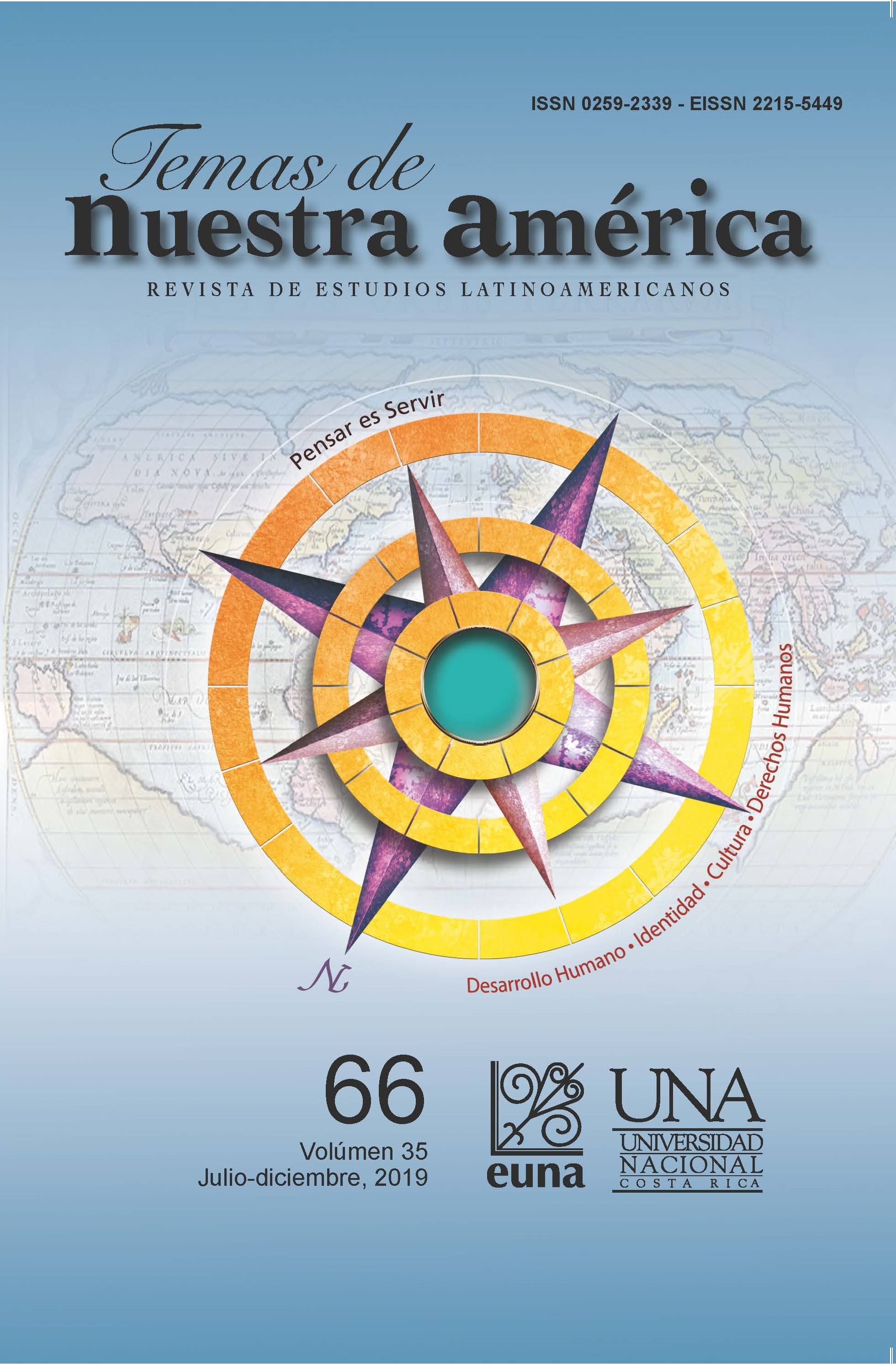Security and Violence in Latin America in the Second Half of the 20th Century Militarism in Latin America and the Cold War
DOI:
https://doi.org/10.15359/tdna.35-66.5Keywords:
national security doctrine, us foreign policy, low intensity conflicts, terroris states, structural violence, imperialismAbstract
This article explores the National Security Doctrine and its reformulation, the Low Intensity Conflicts (LIC), as strategies based on the US territorial and political need to impose their power at the expense of the possibilities of Latin America’s self-management, which have prevailed due to an old creole militarism and a fragmented classist society whose vertical and destructive power relations are rooted in the construction of nation-states. This Latin American class-system and imperial historicity has led to the destruction of communities, cultures and exploitation of resources and people, through impunity exercised by Terrorist States and the institutionalization of structural violence. The violence experienced in times of war, the institutionalization of terror, the manipulation of the masses, the displacement of thousands of people, the institutional genocide, the encompassing of all the tools of progress, and the absolute failure of nation-states to inculacate socio-cultural cohesion and promote peace, entails the construction of a culture of violence in Latin America. Despite the intercontinental measures and the application of the policies of Iron Fist or the War on Drugs, the results have been negative and the consequences have deepened the networks of organized crime, violence, the economic crisis of the states and distrust in the political structure altogether. Therefore, violence in Latin America cannot be measured regionally or combatted unilaterally, on the contrary, it must be managed locally with an interdependent effort by states and communities.
References
Álvarez, A. M. et al. (2007, julio-diciembre). Difusión transnacional de identidades juveniles en la expansión de las maras centroamericanas. Perfiles Latinoamericanos, (30), 101-122
Álvarez, M. (2018, julio-diciembre). Los terrorismos a la tica. Casos y relatos que vinieron a mí. Temas de Nuestra América, Revista de Estudios Latinoamericanos 34 (64),67-81. DOI: https://doi.org/10.15359/tdna.34-64.5
Barrios, M. A. (2016). Geopolítica de la seguridad: crimen organizado y globalización. Alainet. Recuperado de : https://www.alainet.org/es/articulo/181036
Calloni, S. (1994). Los Archivos del Horror. CovertAction. Recuperado de: http://www.derechos.org/nizkor/doc/condor/calloni.html
Cuevas, R. (2012). Cultura y violencia: la cultura de la violencia. En De banana republics a repúblicas maquileras - La cultura en Centroamérica en tiempos de globalización neoliberal (1990-2010) (pp.141-186). San José: Editorial EUNED.
Elbaum, J. (2018). La larga marcha del hambre: éxodos del naufragio neoliberal. Sur y Sur, recuperado de: http://www.surysur.net/la-larga-marcha-del-hambre-exodos-del-naufragio-neoliberal/
Guedes, A. et al. (2014, enero-marzo). Violencia contra las mujeres en Latinoamérica y el Caribe. Foreign Affairs Latinoamerica, 14 (1), 40-48.
Jaitman, L. (2017). Crimen conlleva altos costos sociales, públicos y privados en América Latina y el Caribe: Estudio BID. Comunicados de prensa, Banco Interamericano de Desarrollo. Recuperado de: https://www.iadb.org/es/noticias/comunicados-de-prensa/2017-02-03/cuanto-le-cuesta-el-crimen-a-america-latina%2C11714.html
Kreibohm, P. (2008, enero-marzo). la doctrina de la guerra de baja intensidad: la formulación de una nueva categoría de conflicto. Padeceme, (17), 73-84.
Leal, F. (2003, junio). La doctrina de seguridad nacional: materialización de la Guerra Fría en América del Sur. Revista de Estudios Sociales, (5), 74-87.
Rojas, F. (2008). Globalización y violencia en América Latina: debilidad estatal, inequidad y crimen organizado inhiben el desarrollo humano. Universidad para La Paz.
Solís, J. M. y Moriconi, M. (2018). La violencia letal en América Latina: un flagelo heterogéneo pero generalizado. En Atlas de la violencia en América Latina (pp. 13-105). México: Universidad Autónoma de San Luis Potosí.
Segato, R. (2018). La Violencia contra las mujeres es sobre las mujeres contra la vida. Diálogo con Rita Segato. Fundación Rosa Luxemburgo. Biodiversidad: Recuperado de: http://www.biodiversidadla.org/Documentos/La_violencia_contra_las_mujeres_es_sobre_las_mujeres_contra_la_vida._Dialogo_con_Rita_Segato
Sweedler, A. (S.f.) La política de seguridad de Estados Unidos en la post Guerra Fría.
Woo, O. (2007, enero-abril). La migración: un asunto de seguridad nacional en Estados Unidos en el siglo XXI. México y la Cuenca del Pacífico, 10 (28), 43-52.
Downloads
Published
How to Cite
Issue
Section
License
Esta obra de Revista Temas de Nuestra América está bajo una Licencia Creative Commons Atribución-NoComercial-SinDerivar 4.0 Internacional.
Cualquier permiso que trascienda dicha licencia, debe solicitarse por escrito a la persona directora de la Revista









